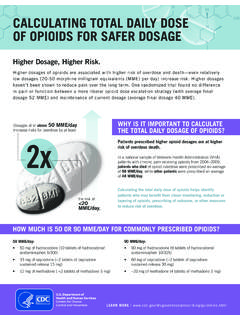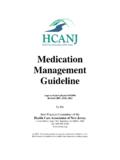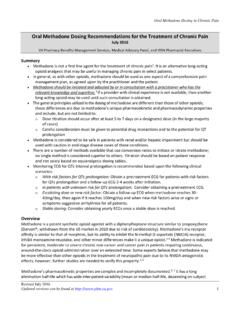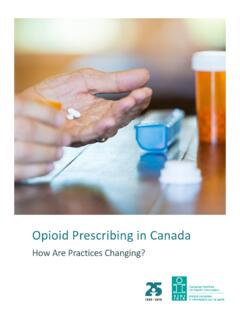Transcription of Clinical Guidelines for Tapering Benzodiazepines
1 1 February 2019 Clinical Guidelines for Tapering Benzodiazepines Introduction Benzodiazepines are associated with significant risks and may no longer be of benefit to individuals you treat. When deemed appropriate, please begin discussions with individuals about possibly Tapering their benzodiazepine regimen. It is also important to consider alternate treatment options and minimize new benzodiazepine prescriptions whenever possible, especially in populations at risk for opioid use. Despite the involved challenges, strategies to taper existing Benzodiazepines prescriptions are General Guidelines A team-based approach is effective when Tapering an individual from Benzodiazepines . The entire treatment team should focus on safe and effective treatment and support for the individual s recovery goals. Reinforce a trusting relationship with individuals you treat. Emphasize the need to find the safest and most effective treatment, with a commitment to achieving recovery goals and not just eliminating Benzodiazepines .
2 Monitor for worsening mental or physical health conditions, substance use relapse, and other potential barriers to successful treatment. Coordinate care with other providers. Use the Prescription Drug Monitoring Program (PDMP). Priorities Any individual taking multiple Benzodiazepines or Benzodiazepines combined with prescribed opiates, other sedatives, or amphetamines Any individual currently struggling with substance use or in recovery from substance use disorder Older individuals (due to risk of injury, cognitive effects) 1 These Guidelines are based on those published by the National Center for PTSD in 2015 ( ), adapted to better suit the CBH network. Other strategies exist. For a more detailed discussion, see also Pollman et al, Deprescribing Benzodiazepines and Z-drugs in Community-Dwelling Adults, a Scoping Review, BMC Pharmacol Toxicol (2015), 16: 19. 2 February 2019 Specific Tapering Recommendations For individuals taking higher than recommended doses Consider admission to an inpatient hospital to minimize medical risks and ensure adequate medical monitoring.
3 Consider switching to long half-life drug. Reduce dose initially by 25-30%. Then reduce dose by approximately 5-10% daily to weekly. Consider anticonvulsant for high dose withdrawal. For individuals taking therapeutic dose bedtime dosing (QHS) Reduce by approximately 25% weekly. Anticipate and educate regarding rebound insomnia which can occur as early as one day. Provide reassurance and sleep hygiene information. Initiate alternate treatment options ( cognitive behavioral therapy (CBT), non-benzodiazepine agents). For individuals taking therapeutic doses daytime dosing (generally QD to QID) Anticipate and provide education regarding rebound anxiety and recurrence of initial anxiety symptoms. Plan additional psychological support during taper. Prepare for the last phase of withdrawal, which is likely to be the most difficult. Anticipate that points of dosing schedule changes ( TID to BID) can be psychologically challenging.
4 Encourage individual to actively participate in developing withdrawal schedule. Initially taper dose typically between 10-25%. Observe for signs of withdrawal. Anticipate early withdrawal for Benzodiazepines with a short half-life ( alprazolam). Individualize subsequent reductions based on initial response. o Generally, further reductions of 10-25% every 1-2 weeks are well tolerated pharmacologically. o Consider slow taper periodically and/or offer additional psychological support as individuals learn new ways of coping with their anxiety or adjust to new treatments. For very long-term use or high doses, a pause at 50% of the initial dose for a period of 1-2 months may be effective. For individuals taking concurrent opioids Co-prescribing of Benzodiazepines and opiates can lead to pain-related behavioral management problems and place individuals at higher risk for fatal and non-fatal overdose. Often, prescriptions for these medications are given by different prescribers; work with individuals and their other care providers to determine best treatment options.
5 Generally, any decrease in these medications is a move in the right direction. Let the individual guide the decision about where to start. Consider duloxetine or amitriptyline to help with pain and anxiety while reducing need for Benzodiazepines and opioids. 3 February 2019 Additional strategies for complex cases Consider being flexible with schedule. Consider switching to a long-acting benzodiazepine (particularly helpful with long-term use, supratherapeutic doses, or short half-life Benzodiazepines ). Establish a support team (primary care physician, case manager, therapists, group facilitators, pharmacists, residential treatment, etc.). Example Tapers Note that switching to a longer-acting benzodiazepine may be considered if clinically appropriate. These are suggestions only; high-dose alprazolam may not have complete cross tolerance; a gradual switch to diazepam before taper may be appropriate; other treatment modalities ( antidepressants) for anxiety should be considered if clinically appropriate.
6 Approximate Dose Conversion and Half-Life Medication Equivalent Dose Elimination Half-Life Chlordiazepoxide 10 mg >100hr Diazepam 5 mg >100hr Clonazepam mg 20-50 hr Lorazepam 1 mg 10-20 hr Alprazolam mg 12-15 hr Temazepam 10-20 mg 10-20 hr 4 February 2019 Example 1 A Tapering schedule like the one below can be shared with the individual to help everyone know what to expect. Dose decreases are generally better tolerated than frequency decreases. Timing should be individualized ( prioritizing the QHS dose in the case of rebound insomnia). Example 2 Changing to a longer-acting agent can help prevent rebound anxiety and withdrawal symptoms. In the example below, a Tapering plan for an individual originally taking 1mg QID (4mg total daily dose) of alprazolam (equivalent to 40mg diazepam) is shown. Example Benzodiazepine Taper 1 Week 1 .5mg QAM and then 1mg TID Week 2 Decrease dose by 25% 1mg TID Week 3 .5mg QAM and then 1mg BID Week 4 Decrease dose by 25%.
7 5 BID and 1mg QHS (50% of original dose) Week 5-8 Hold dose 1-2 months Continue at 20 mg/day for 1 month Week 9-10 .5mg TID Week 11-12 Decrease dose by 25% at week 11 .5mg BID Week 13-14 Decrease dose by 25% at week 13 .5mg Daily or QHS Week 15 discontinue Example Benzodiazepine Taper 2 Week 1 35 mg/day Week 2 Decrease dose by 25% 30 mg/day (25%) Week 3 25 mg/day Week 4 Decrease dose by 25% 20 mg/day (50%) Week 5-8 Hold dose 1-2 months Continue at 20 mg/day for 1 month Week 9-10 15 mg/day Week 11-12 Decrease dose by 25% at week 11 10 mg/day Week 13-14 Decrease dose by 25% at week 13 5 mg/day Week 15 discontinue



